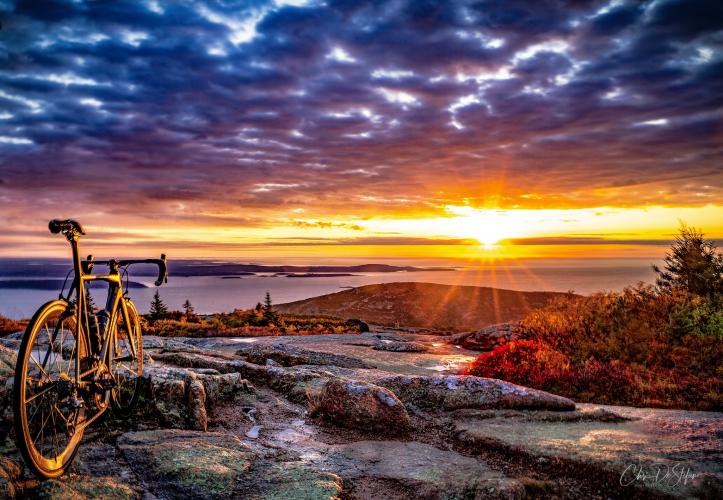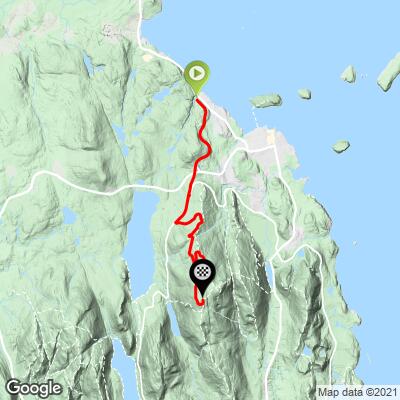![]()
Cycling Cadillac Mountain -- the best bike climb in Maine
Ride 5.6 miles gaining 1,449’ at 4.8% average grade (5.9% climb only).
![]()
Climb begins at the National Park Visitor Center.
John Summerson:
“Located in Acadia National Park right on the picturesque Maine coast, Cadillac Mountain is a very scenic climb that rises from just above sea level and is very likely the most difficult ascent in the state. It is over mostly moderate and fairly steady grade along the majority of its route. The views on top are quite good and you will likely have some company (mostly auto traffic) on your way up but not so much that it ruins the climb.
From climb start at the junction of Routes 3 and 223 in Bar Harbor, head south on 223 over shallow grade. You then stair step up the hill which includes a small descent. The grade then gradually increases and at mile 1.1 bear right into the national park to find a short stretch of solid grade. At the junction turn left to find shallow grade. From this point you ride along up and down slope for one mile with some traffic most days. At mile 2.2, turn left to the summit into the woods and find the steepest sustained climbing on the hill. Soon very good views appear to your left as you ride along the ridgeline as the trees disappear. The grade eventually eases back and then when it ramps up again, more very good scenery is encountered. Towards the summit you find a short descent. Climbing then resumes over shallow grade and the hill ends at a parking area with hiking possibilities. The descent of Cadillac Mountain is mostly uncomplicated except perhaps for its intermittent traffic.” (This quote is presented with the approval of John Summerson, from his book, The Complete Guide to Climbing (by Bike) in the Northeast, pg. 68.)
Cadillac Mountain, located within Maine’s Acadia National Park on Mount Desert Island (MDI), sits at 1,530 feet and is the highest point on the North Atlantic seaboard. The mountain is one of twenty on MDI, and is famous in part for being the first place to view the sunrise in the United States from early October through early March each year. Cadillac Summit Road is the paved road to the top of the mountain, and winds up the approximately 3.5 miles to the mountaintop. On a clear day from the top of the summit road, its possible to see Mount Katahdin, Maine’s highest point, in the distance. You can read more about Cadillac Summit road here.
![]()
Sunrise on Cadillac Mountain
Along the other mountains on MDI, Cadillac Mountain was formed by being pushed up by the earth’s tectonic plates and volcanic forces millions of years ago. Huge glaciers sheared off these mountains’ tops, causing the mountains we see today to be shorter than they once were. More information on the glaciers that once crept across the area can be found here.
![]()
Cadillac Mountain is all granite.
The history of the roadways within Acadia National Park is rich. Between 1913 and 1940, the construction of 57 miles of Carriage Roads was financed and directed by John D. Rockefeller, Jr. These roads were built for use by hikers, bikers, horse riders, and carriages on MDI, and granite was quarried from the island to be used for roadway material and bridge facings. Today, this network of woodland “broken-stone” roads remains free of car traffic. 45 of the 57 miles of roadway exist within Acadia National Park, and some are used for cross-country skiing and even snowmobiling. More information on this unique and diverse roadway system can be found here.
![Cycling Cadillac Mountain, Maine Cycling Cadillac Mountain, Maine - carriage road and wooden signpost in Acadia National Park]()
A carriage roadway and wooden signpost in Acadia National Park
Photo: NPS
2024 Climb Summary by PJAMM ambassador Dan Razum.
This is a great climb in Acadia National Park. Acadia has a lot of biking, both trails and paved roads, so it is a great cycling destination. Cadillac Mountain is definitely worth riding for the scenery and the workout. It is popular to watch the sun rise from the top of the mountain but we weren't up for riding in the dark, so we arrived well after sunrise.
There is a large parking lot at the Visitor Center in Hulls Cove, just north of Bar Harbor. The parking lot fills up completely, so make sure you arrive early if you want to park there. There is no charge for parking but there is an entrance fee to the park itself. You can purchase the entrance pass from a machine in front of the Visitor Center. The Visitor Center itself opens at 8:30 am. There are bathrooms in the Visitor Center but they are not accessible from the outside of the building so you can't use the bathrooms before 8:30 am. Rather strange, many other places we've visited have bathroom access from both inside and outside the building, so the bathrooms are available 24/7. But not here, for some strange reason.
![]()
Photo left - early arrival to the parking lot; Photo right - late arrival.
If you park at the Visitor Center then it is a short ride along Paradise Hill Rd to reach the start of the climb. There are plenty of signs to go to Cadillac Mountain so there is no concern about getting lost, just exit the parking lot and follow the signs.
![]()
We started early in the morning, before there was much traffic. However, when traffic picks up it really isn't bad, the cars are slow and enjoying the park, same as us. By mid day there is definitely a lot of traffic but it was never a concern. Around the pulloffs along the road you will need to watch for pedestrians and people opening car doors to get out but that's all part of sharing the park.
![]()
Views of Eagle Lake to our right as we climb.
The bulk of the climb is on Cadillac Summit Rd. Cars are required to have a reservation to drive on this road, but cyclists are fine, no reservation required. This does help reduce the traffic on this section of the climb, which we appreciated, as cyclists. After we get on Cadillac Summit Road the gradient does kick up, but it's never too steep. As we climb higher there are good views of Eagle Lake and the surrounding landscape. The climb ends at the East Lot on top of the mountain. There aren't any views from the East Lot itself but you can walk a short distance on some paths to reach amazing views of the land and sea in all directions.
![]()
Top of climb - Cadillac Mountain Gift Shop and overlook.

 We've partnered with Sherpa-Map.com to bring you the best route planning tool. With a PRO Membership you can use this climb as a reference when creating your route.
We've partnered with Sherpa-Map.com to bring you the best route planning tool. With a PRO Membership you can use this climb as a reference when creating your route. 





